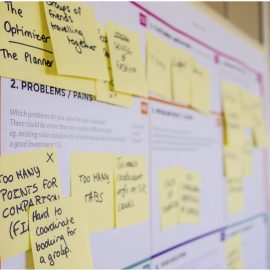

This article is an excerpt from the Shortform summary of "Getting Things Done" by David Allen. Shortform has the world's best summaries of books you should be reading.
Like this article? Sign up for a free trial here .
What is the GTD “capture” step, and how does it work? What does “capturing” help you with when you’re trying to get organized?
The GTD capture tool is used in Getting Things Done. GTD capture is a way to understand and assess your situation and the tasks you need to complete.
What Is GTD Capture?
The Getting Things Done system has five steps:
- Capture all the problems and ideas that are taking your attention.
- Clarify what each one means and what you need to do about it.
- Organize the decisions and actions you’ve clarified.
- Reflect on everything in front of you to choose what to tackle next.
- Engage with the task (get it done).
Devote time to each step individually, rather than trying to go through all five at once: Take some time to sit and capture everything in your head, go through and clarify all those items during another sitting, and so on.
Most people do these five steps naturally, but not as efficiently as they could. Many people fall into one of these traps:
- They don’t capture everything, leaving too many open loops in their heads.
- They don’t clarify sufficiently, so they have ambiguous to-do lists, notes, and reminders that don’t tell them exactly what to do.
- They don’t organize efficiently, so the reminders get lost and tasks don’t get done in a timely way.
- They don’t spend enough time reflecting, so they have lists, calendars, and reminders that are overloaded and out-of-date.
- They tackle whatever is the most immediate and demanding instead of making strategic decisions about what to engage in.
Let’s talk about each step, and in later chapters we’ll explore them in more detail.
How to Use GTD Capture
The first critical step is to GTD capture every idea, reminder, and piece of information and get it out of your head. Capture everything—big and small, short-term and long-term, anything in your life that you feel should be different and that you have some motivation or commitment to change—from career strategy ideas to a reminder to fix that gadget in your junk drawer.
Put all these things into “containers,” which can be:
- Paper notebooks, note cards, or pads
- Physical in-trays
- Emails or text messages
- Digital or audio note-taking systems/apps
Whatever type of container you use, make sure that it is always with you so that you can capture something as soon as the thought enters your head.
There are three requirements for a successful Getting Things Done capture system:
- Capture every open loop. If you still have things floating around in your head, you won’t have the mental energy to sort through and empty your containers (that’s the next step).
- Have as few capturing buckets as possible. If you have too many, the system will get unmanageable and you won’t be able to go through the containers regularly.
- Empty your containers regularly. If your containers get backlogged, things get lost and your brain won’t trust your system, so it will keep reminding you of things even after you’ve captured them. You don’t have to complete the tasks in order to empty the containers—you just have to clarify and organize them.
Set Yourself Up for GTD Success With Capturing
Now that you’ve learned the models and the methods, it’s time to start applying the Getting Things Done program to your life. GTD capture is the first step.
It’s one thing to know what you should do, and quite another to actually do it, so Part 2 provides some coaching and practical tools for implementing the GTD system. You can implement the full-scale system, or adopt a few aspects and implement more over time.
Dedicate Time
Your biggest time investment will be in getting the GTD system up and running. It takes most people two days back-to-back to fully get things started—about a day to use Getting Things Done capture and another day to clarify and determine next actions.
The initial process takes a lot of mental energy, so aim to dedicate a day or two to it with no distractions. If you work on this after you get home from work at the end of the day, your energy will probably be too tapped to effectively use the GTD capture tool and clarify everything without falling down rabbit holes.
Once you have the system set up and in place, you’ll be able to maintain it during much shorter windows of free time in your days.
GTD capture is a way to gain knowledge about what’s going on around you, and learn to plan ahead. With the GTD capture tool, you can determine and prioritize your next steps.

———End of Preview———
Like what you just read? Read the rest of the world's best summary of David Allen's "Getting Things Done" at Shortform .
Here's what you'll find in our full Getting Things Done summary :
- Why you're disorganized and your to-do list is a mess
- The simple workflow you can do everyday to be more productive than ever
- How to take complicated projects and simplify them






